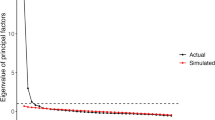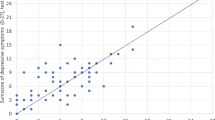Abstract
Psychosocial factors, including perceived disability and self-efficacy, are important determinants of outcome for individuals with chronic back pain. Consequently, there is a need for an evaluation and consideration of such factors in occupational rehabilitation. This study evaluated the reliability and validity of a tool, the Spinal Function Sort, as a measure of perceived capacity for work-related tasks with 42 rehabilitation clients with chronic back pain. Results provided support for the internal consistency (Cronbach's alpha of 0.97), test-rest reliability (ICC of 0.89) and construct validity of the Spinal Function Sort as a measure of perceived capacity for work-related tasks in persons with chronic back pain. Measures of similar constructs were significantly correlated with the Spinal Function Sort and were highly predictive of the Spinal Function Sort on multiple regression. Relationships between perceived work capacity and pain intensity and gender are discussed. The need for the consideration of perceived capacity in the evaluation and rehabilitation of persons with chronic back pain is highlighted.
Similar content being viewed by others
References
Frederickson BE, Trief PM, VanBeveren P, Yuan HA, Baum G. Rehabilitation of the patient with chronic back pain. A search for outcome predictors.Spine 1988; 13: 351–353.
Gervais S, Dupuis G, Veronneau F, Bergeron Y, Millette D, Avard J. Predictive model to determine cost/benefit of early detection and intervention in occupational low back pain.J Occup Rehab 1991; 1: 113–131.
Kinney RK, Gatchel RJ, Polatin PB, Mayer TG. The functional restoration approach for chronic spinal disability.J Occup Rehab 1991; 1: 235–243.
Lichter RL, Hewson JK, Radke SJ, Blum M. Treatment of chronic low back pain. A community-based comprehensive return-to-work physical rehabilitation program.Clin Orthop 1984; 190: 115–123.
Milhous RL, Haugh LD, Frymoyer JW, Ruess JM, Gallagher RM, Wilder DG, Callas PW. Determinants of vocational disability in patients with low back pain.Arch Phys Med Rehab 1989; 70: 589–593.
Feuerstein M, Thebarge RW. Perceptions of disability and occupational stress as discriminators of work disability in patients with chronic pain.J Occup Rehab 1991; 1: 185–195.
Scheer SJ, Wickstrom RJ. Vocational capacity with low back pain impairment. In: Scheer SJ, ed.Medical perspectives in vocational assessment of injured workers, Maryland: Aspen Publishers, 1991, pp. 19–63.
Volinn E, Van Koevering D, Loeser JD. Back sprain in industry. The role of socioeconomic factors in chronicity.Spine 1991; 16: 542–548.
Dionne C, Turcotte F. Coping with low back pain: Remaining disabilities 5 years after multidisciplinary rehabilitation.J Occup Rehab 1992; 2: 73–88.
Lusted M. Predicting return to work after rehabilitation for low back injury.Aust Physiotherapy 1993; 39: 203–210.
Feuerstein M, Menz L, Zastowny T, Barron BA. Chronic back pain and work disability: Vocational outcomes following multidisciplinary rehabilitation.J Occup Rehab 1994; 4: 229–251.
Waddell G. A new clinical model for the treatment of low back pain.Spine 1987; 12: 632–644.
Feuerstein M. A multidisciplinary approach to the prevention, evaluation and management of work disability.J Occup Rehab 1991; 1: 5–12.
Turk DC, Rudy TE. Persistent pain and the injured worker: Integrating biomedical, psychosocial, and behavioral factors in assessment.J Occup Rehab 1991; 1: 159–179.
Cats-Baril WL, Frymoyer JW. Identifying patients at risk of becoming disabled because of low-back pain. The Vermont Rehabilitation Engineering Center predictive model.Spine 1991; 16: 605–607.
Deyo RA, Andersson G, Bombardier C, Cherkin DC, Keller RB, Lee CK, Liang MH, Lipscomb B, Shekelle P, Spratt KF, Weinstein JN. Outcome measures for studying patients with low back pain.Spine 1994; 19: 2032S-2036S.
Scheer SJ, Radack KL, O'Brien DR. Randomized controlled trials in industrial low back pain relating to return to work. Part I. Acute interventions.Arch Phys Med Rehab 1995; 76: 966–973.
Gallagher RM, Rauh V, Haugh LD, Milhous R, Callas PW, Langelier R, McClallen JM, Frymoyer J. Determinants of return-to-work among low back pain patients.Pain 1989; 39: 55–67.
Frymoyer JW. Predicting disability from low back pain.Clin Orthop Rel Res 1992; 279: 101–109.
Eklund M. Chronic pain and vocational rehabilitation: A multifactorial analysis of symptoms, signs and psycho-socio-demographics.J Occup Rehab 1992; 2: 53–66.
Lancourt J, Kettelhut M. Predicting return to work for lower back pain patients receiving worker's compensation.Spine 1992; 17: 629–640.
Burton AK, Tillotson KM, Main CJ, Hollis S. Psychosocial predictors of outcome in acute and subchronic low back troubleSpine 1995; 20: 722–728.
Sandström J, Esbjörnsson E. Return to work after rehabilitation. The significance of the patient's own prediction.Scand J Rehab Med 1986; 18: 29–33.
Papciak AS, Feuerstein M. Psychological factors affecting isokinetic trunk strength testing in patients with work-related chronic low back pain.J Occup Rehab 1991; 1: 95–104.
Hirsch G, Beach G, Cooke C, Menard M, Locke S. Relationship between performance on lumbar dynamometry and Waddell score in a population with low back pain.Spine 1991; 16: 1039–1043.
Carosella AM, Lackner JM, Feuerstein M. Factors associated with early discharge from a multidisciplinary work rehabilitation program for chronic back pain.Pain 1994; 57: 69–76.
Lackner JM, Carosella AM, Feuerstein M. Pain expectancies, pain and functional self efficacy expectancies as determinants of disability in chronic low back patients.J Consult Clin Psychol 1996; 64: 212–220.
Bandura A. Self-efficacy: Toward a unifying theory of behavioral change.Psychol Rev 1977; 84: 191–215.
Bandura A. Self-efficacy mechanism in human agency.Am Psychol 1982; 37: 122–147.
Jensen MP, Turner JA, Romano JM. Self-efficacy and outcome expectancies: Relationship to chronic pain coping strategies and adjustment.Pain 1991; 44: 263–269.
Council JR, Ahern DK, Follick MJ, Kline CL. Expectancies and functional impairment in chronic low back pain.Pain 1988; 33: 323–331.
Dolce JJ, Crocker MF, Molotteire C, Doleys DM. Exercise quotas, anticipatory concern and self-efficacy expectancies in chronic pain: A preliminary report.Pain 1986; 24: 365–372.
Kores RC, Murphy WD, Rosenthal TL, Elias DB, North WC. Predicting outcome of chronic pain treatment via a modified self-efficacy scale.Behav Res Ther 1990; 28: 165–169.
Strong J. Self-efficacy and the patient with chronic pain. In: Shacklock MO, ed.Moving in on pain. Australia: Butterworth-Heinemann, pp. 97–102.
Estlander A-M, Vanharanta H, Moneta GB, Kaivanto K. Anthropometric variables, self-efficacy beliefs, and pain and disability ratings on the isokinetic performance of low back pain patients.Spine 1994; 19: 941–947.
Kaivanto K, Estlander A-M, Moneta GB, Vanharanta H. Isokinetic performance in low back pain patients: The predictive power of the Self-Efficacy Scale.J Occup Rehab 1995; 5: 87–99.
Deyo RA. Measuring the functional status of patients with low back pain.Arch Phys Med Rehab 1988; 69: 1044–1053.
Millard RW. A critical review of questionnaires for assessing pain-related disability.J Occup Rehab 1991; 1: 289–302.
Kopec JA, Esdaile JM. Functional disability scales for back pain.Spine 1995; 20: 1943–1949.
Tait RC, Pollard CA, Margolis RB, Duckro PN, Krause SJ. The Pain Disability Index: Psychometric and validity data.Arch Phys Med Rehab 1987; 68: 438–441.
Tait RC, Chibnall JT, Krause S. The Pain Disability Index: Psychometric properties.Pain 1990; 40: 171–182.
Bergner M, Bobbitt RA, Carter WB, Gilson BS. The Sickness Impact Profile: Development and final revision of a health status measure.Med Care 1981; 19: 787–805.
Evans JH, Kagan A. The development of a functional rating scale to measure the treatment outcome of chronic spinal patients.Spine 1986; 11: 277–281.
Fairbank JCT, Couper J, Davies JB, O'Brien JP. The Oswestry low back pain disability questionnaire.Physiotherapy 1980; 66: 271–273.
Millard RW. The Functional Assessment Screening Questionnaire: Application for evaluating pain-related disability.Arch Phys Med Rehab 1989; 70: 303–307.
Strong J, Ashton R, Large RG. Function and the patient with chronic low back pain.Clin J Pain 1994; 10: 191–196.
DeGood DE, Shutty MS. Assessment of pain beliefs, coping and self-efficacy. In: Turk DC, Melzack R, ed.Handbook of pain assessment. New York: The Guilford Press, 1992, pp. 214–234.
Nicholas MK. Pain Self-Efficacy Questionnaire. Unpublished tool, Pain Management Centre, St. Thomas' Hospital, London, 1988.
Anderson KA, Dowds BN, Pelletz RE, Edwards WT, Peeters-Asdourian C. Development and initial validation of a scale to measure self-efficacy beliefs in patients with chronic pain.Pain 1995; 63: 77–84.
Dolce JJ, Crocker MF, Molotteire C, Doleys DM. Prediction of outcome among chronic pain patients.Behav Res Ther 1986; 24: 313–319.
Eklund M, Eriksson S, Fugl-Meyer AR. Vocational rehabilitation in northern Sweden II. Some psycho-socio-demographic predictors.Scand J Rehab Med 1991; 23: 73–82.
Foreman P, Murphy G. Motivational factors influencing return to work outcomes: The role of the injured employee's values and expectations. In:Rehabilitation: Reducing the cost of injury and disability. Proceedings of the Second National Rehabilitation Conference. May 12–14, 1993; Sydney, Australia, pp. 611–620.
Matheson LN, Matheson ML, Grant J. Development of a measure of perceived functional ability.J Occup Rehab 1993; 3: 15–30.
Ryckman RM, Robbins MA, Thornton B, Cantrell P. Development and validation of a physical self-efficacy scale.J Person Soc Psychol 1982; 42: 891–900.
Gage M, Noh S, Polatajko HJ, Kaspar V. Measuring perceived self-efficacy in occupational therapy.Am J Occup Ther 1994; 48: 783–790.
United States Department of Labor, Employment & Training Administration.Dictionary of occupational titles. Washington, D.C., 1986.
United States Department of Labor, Employment & Training Administration.The Revised Handbook for Analyzing Jobs. Indianapolis: JIST Works, 1991.
Deyo RA, Diehr P, Patrick DL. Reproducibility and responsiveness of health status measures. Statistics and strategies for evaluation.Contr Clin Trials 1991; 12: 142S-158S.
Ottenbacher KJ, Tomchek SD. Reliability analysis in therapeutic research: Practice and procedures.Am J Occup Ther 1993; 47: 40–46.
Streiner DL, Norman GR.Health measurement scales: A practical guide to their development and use. New York: Oxford University Press, 1989, p. 25.
Matheson LN, Matheson M.Spinal function sort. Rancho Santa Margarita, CA: Performance Assessment and Capacity Testing, 1989.
Nicholas MK.Pain Self Efficacy Questionnaire (PSEQ): Preliminary Report. Unpublished manuscript, University of Sydney Pain Management and Research Centre, Royal North Shore Hospital, Sydney, 1994.
Nicholas MK, Wilson PH, Goyen J. Comparison of cognitive-behavioral group treatment and an alternative nonpsychological treatment for chronic low back pain.Pain 1992; 48: 339–347.
Grönblad M, Hupli M, Wennerstrand P, Järvinen E, Lukinmaa A, Kouri JP, Karaharju EO. Intercorrelation and test-retest reliability of the Pain Disability Index (PDI) and the Oswestry Disability Questionnaire (ODQ) and their correlation with pain intensity in low back pain patients.Clin J Pain 1993; 9: 189–195.
Grönblad M, Järvinen E, Hurri H, Hupli M, Karaharju EO. Relationship of the Pain Disability Index (PDI) and the Oswestry Disability Questionnaire (ODQ) with three dynamic physical tests in a group of patients with chronic low-back and leg pain.Clin J Pain 1994; 10: 197–203.
Feuerstein M, Papciak AS.Work Reentry Questionnaire. Unpublished manuscript, 1989.
Strong J, Ashton R, Chant D. Pain intensity measurement in chronic low back pain.Clin J Pain 1991; 7: 209–218.
Tabachnik BG, Fidell LS.Using multivariate statistics (2nd Ed). New York: Harper Collins Publishers, 1989.
Fishbain DA, Rosomoff HL, Goldberg M, Cutler R, Abdel-Moty E, Khalil TM, Rosomoff RS. The prediction of return to the workplace after multidisciplinary pain center treatment.Clin J Pain 1993; 9: 3–15.
Vlaeyen JWS, Kole-Snijders AMJ, Boeren RGB, van Eek H. Fear of movement/(re)injury in chronic low back pain and its relation to behavioral performance.Pain 1995; 62: 363–372.
Van Den Ende CHM, Hazes JMW, le Cessie S, Breedveld FC, Dijkmans BAC. Discordance between objective and subjective assessment of functional ability of patients with rheumatoid arthritis.Br J Rheum 1995; 34: 951–955.
Fishbain DA, Abdel-Moty E, Cutler R, Khalil TM, Sadek S, Rosomoff RS, Rosomoff HL. Measuring residual functional capacity in chronic low back pain patients based on the Dictionary of Occupational Titles.Spine 1994; 19: 872–880.
Lechner D, Roth D, Straaton K. Functional capacity evaluation in work disability.Work 1991; 1: 37–47.
Lackner JM, Carosella AM. Functional Efficacy Scale.J Consult Clin Psychol (in press).
Tate DG. Workers' disability and return to work.Am J Phys Med Rehab 1992; 71: 92–96.
Author information
Authors and Affiliations
Rights and permissions
About this article
Cite this article
Gibson, L., Strong, J. The reliability and validity of a measure of perceived functional capacity for work in chronic back pain. J Occup Rehab 6, 159–175 (1996). https://doi.org/10.1007/BF02110753
Issue Date:
DOI: https://doi.org/10.1007/BF02110753




